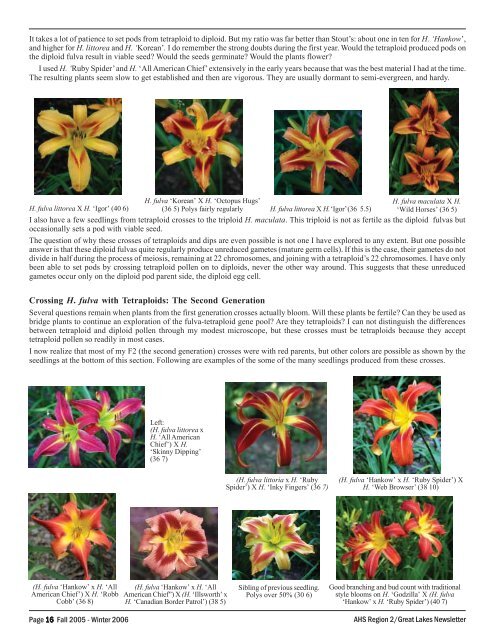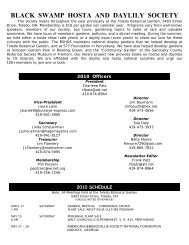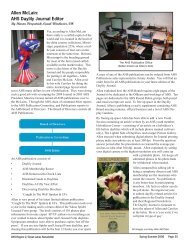Pages - AHS Region 2
Pages - AHS Region 2
Pages - AHS Region 2
You also want an ePaper? Increase the reach of your titles
YUMPU automatically turns print PDFs into web optimized ePapers that Google loves.
It takes a lot of patience to set pods from tetraploid to diploid. But my ratio was far better than Stout’s: about one in ten for H. ‘Hankow’,<br />
and higher for H. littorea and H. ‘Korean’. I do remember the strong doubts during the first year. Would the tetraploid produced pods on<br />
the diploid fulva result in viable seed Would the seeds germinate Would the plants flower<br />
I used H. ‘Ruby Spider’ and H. ‘All American Chief’ extensively in the early years because that was the best material I had at the time.<br />
The resulting plants seem slow to get established and then are vigorous. They are usually dormant to semi-evergreen, and hardy.<br />
H. fulva littorea X H. ‘Igor’ (40 6)<br />
H. fulva ‘Korean’ X H. ‘Octopus Hugs’<br />
(36 5) Polys fairly regularly<br />
H. fulva littorea X H. ‘Igor’ (36 5.5)<br />
H. fulva maculata X H.<br />
‘Wild Horses’ (36 5)<br />
I also have a few seedlings from tetraploid crosses to the triploid H. maculata. This triploid is not as fertile as the diploid fulvas but<br />
occasionally sets a pod with viable seed.<br />
The question of why these crosses of tetraploids and dips are even possible is not one I have explored to any extent. But one possible<br />
answer is that these diploid fulvas quite regularly produce unreduced gametes (mature germ cells). If this is the case, their gametes do not<br />
divide in half during the process of meiosis, remaining at 22 chromosomes, and joining with a tetraploid’s 22 chromosomes. I have only<br />
been able to set pods by crossing tetraploid pollen on to diploids, never the other way around. This suggests that these unreduced<br />
gametes occur only on the diploid pod parent side, the diploid egg cell.<br />
Crossing H. fulva with Tetraploids: The Second Generation<br />
Several questions remain when plants from the first generation crosses actually bloom. Will these plants be fertile Can they be used as<br />
bridge plants to continue an exploration of the fulva-tetraploid gene pool Are they tetraploids I can not distinguish the differences<br />
between tetraploid and diploid pollen through my modest microscope, but these crosses must be tetraploids because they accept<br />
tetraploid pollen so readily in most cases.<br />
I now realize that most of my F2 (the second generation) crosses were with red parents, but other colors are possible as shown by the<br />
seedlings at the bottom of this section. Following are examples of the some of the many seedlings produced from these crosses.<br />
Left:<br />
(H. fulva littorea x<br />
H. ‘All American<br />
Chief’) X H.<br />
‘Skinny Dipping’<br />
(36 7)<br />
(H. fulva littoria x H. ‘Ruby<br />
Spider’) X H. ‘Inky Fingers’ (36 7)<br />
(H. fulva ‘Hankow’ x H. ‘Ruby Spider’) X<br />
H. ‘Web Browser’ (38 10)<br />
(H. fulva ‘Hankow’ x H. ‘All<br />
American Chief’) X H. ‘Robb<br />
Cobb’ (36 8)<br />
(H. fulva ‘Hankow’ x H. ‘All<br />
American Chief”) X (H. ‘Illsworth’ x<br />
H. ‘Canadian Border Patrol’) (38 5)<br />
Sibling of previous seedling.<br />
Polys over 50% (30 6)<br />
Good branching and bud count with traditional<br />
style blooms on H. ‘Godzilla’ X (H. fulva<br />
‘Hankow’ x H. ‘Ruby Spider’) (40 7)<br />
Page 16 Fall 2005 - Winter 2006 <strong>AHS</strong> <strong>Region</strong> 2/Great Lakes Newsletter














